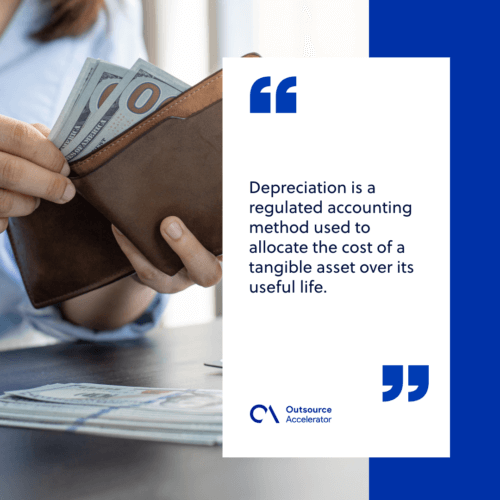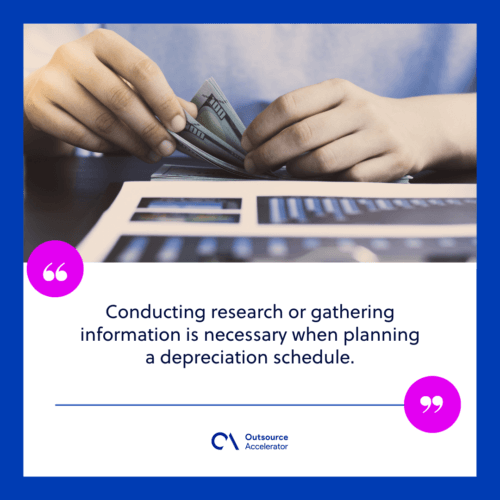What is depreciation? A business perspective

Monitoring financial performance and managing assets are important to running a successful business. This involves not only knowing the current value of your assets but also understanding how they lose value over time.
Depreciation is a standard accounting principle that helps businesses track the gradual decrease in the value of assets. It’s essential for accurate financial reporting, budgeting, and tax planning.
This article explains how depreciation works and why it’s important from a business perspective.
What is depreciation?
Depreciation is a regulated accounting method used to allocate the cost of a tangible asset over its useful life.
Instead of expensing the full cost in the year of purchase, businesses spread the expense across the asset’s expected lifespan.
This process gives businesses a standardized way to allocate costs and helps align expenses with revenue generation. Different depreciation methods can be applied, depending on the nature and usage of the asset.

Impacts of depreciation on business assets
As mentioned, depreciation also varies depending on what kind of assets are available. Small companies usually depreciate various types of assets, which include:
- Real estate
- Equipment and machinery
- Vehicles
- IT infrastructures and computers
- Office equipment
Some companies are challenged to answer the question of what depreciation is and its significant impact on their business assets. This knowledge is crucial for making more informed decisions about financial activity.
Here is the breakdown of its key impacts that will guide your company in implementing the depreciation process:
#1 Modifying investors’ perception
In a financial statement, an asset’s depreciation reflects an amount that reduces the organization’s total net income. It is a cost deducted from the value of an asset over time.
Altering the financial statement through depreciation also helps the company to portray more sustainable economic stability.
It modifies how investors perceive the capability of the business, attracting more partnerships and successful lead generation.
#2 Asset management and planning
Depreciation gives a 360-degree view of what and how much the current total asset costs are, which helps the team properly manage their assets and plan for future replacements.
Companies need to estimate assets for replacement so that providing fund allocations and budgeting will not be difficult.
#3 Reducing taxable income
Depreciation allows businesses to deduct a portion of an asset’s cost each year, lowering taxable income.
This improves cash flow and supports long-term financial planning—especially valuable for small and midsize enterprises.
Types of depreciation methods
Various types of depreciation methods may be adopted by a company to prepare its financial statements or book transactions.
The difference between the amount deducted on tax returns and depreciation led some businesses to utilize different methods for recording taxes and financial statements.
Compared to small businesses, midsize to well-established firms usually prepare their books by directly integrating tax depreciation methods for taxes and financial statements.
Let’s take a look at the common types of depreciation methods and what will fit your books and taxes:
#1 Straight-line depreciation
Most tax specialists refer to this as the simplest type of depreciation. Straight-line depreciation spreads the asset cost evenly over its useful life.
Formula: (Cost of asset – Salvage value) / Useful life
Straight-line is very convenient, especially for small businesses with limited resources and that cannot afford to shoulder additional expenses for hiring a virtual assistant and in-house tax specialist or accountant.
For example, a firm bought a computer for $10,000.00 for a Point-of-Sale system. It has a salvage value of $900.00 and a useful life of 15 years.
(10,000 – 900) / 15 = $606.67
The computation shows the company will deduct $606.67 from the computer value for 15 consecutive years.
#2 Sum-of-the-Years’ Digits (SYD) Depreciation
SYD is another type of depreciation method that allows the business to depreciate an asset’s value during the early stage of its assessed useful life and become lesser in the succeeding years.
This type also allows the business to fairly distribute its depreciation cost and recover the higher value of an asset.
Anchoring to the earlier example, the formula for SYD is (remaining life span / SYD) x (asset cost – salvage value).
With the 15-year life span of a computer, below is the demonstration to determine the total digits for its life span:
1+2+3+4+5+6+7+8+9+10+11+12+13+14+15=120
Now, place the given factors into the equation with the sum of digits for its useful life span. The computation will guide you on the amount that will be less for the first, second, and final years:
First year: (15 / 120) x (10,000 – 900) = $1,137.50
Second year: (14 / 120) x (10,000 – 900) = $1,061.67
Final year: (1 / 120) x (10,000 – 900) = $75.83
Based on the above computation, $75.83 will be written off for the final year using the SYD depreciation method.
#3 Double-declining balance depreciation
This method doubles the straight-line depreciation rate. It also gives a higher value of depreciation expense in the early years of the asset’s useful life span.
The working formula for this type is (2 x straight-line depreciation rate) x (book value at the beginning of the year).
Since the computer’s productive life span is 15 years, the straight-line depreciation rate is 6.6667% using the formula (1 / years of useful life).
Placing again the factors given to the equation, below is the computation to guide you on the amount that will be less for the first, second, and final years:
(2 x 6.6667%) x 10,000 = $1,333.34
(2 x 6.6667%) x 8,666.66 = $1,155.56
(2 x 6.6667%) x 7,511.10 = $1,001.48
As you can see, the first year wrote off almost double the amount using the straight-line method, but reflected the remaining book value in the succeeding year instead of the original cost.
You may also observe that the salvage value is not a factor in the formula for double declining balance depreciation.
#4 Units of production depreciation
The last method uses a basic process to depreciate based on its output or usage.
It is best for startup businesses who want to write off equipment with a measurable output within its entire useful life span. It is commonly used for high-value machinery and equipment.
The formula for this type of depreciation is (asset cost – salvage value) / units produced in useful life.
Let us use the example to elaborate the equation since hours can be a factor in our formula.
Remember that the computer costs $10,000 and has a $900 salvage value, giving it a $9,100 book value.
If a manufacturer of the computer says that it has a total of 50,000 hours throughout its useful life span, its hourly depreciation cost will be 0.182 using the formula below:
(Book value / Expected units of production of an asset) = Hourly depreciation rate)
$9100 / 50,000 = 0.182
If the company owner recorded 10,000 hours of computer usage during its first year, the computation gives us the amount written off for the first year.
10,000 x 0.182 = $1,820
Based on computation, the owner can record a $1,820 depreciation value for the first year, which changes every year, and a total of $9,100 or 50,000 hours until the asset has been fully used or depreciated.
How to plan a depreciation schedule?
In the US, the Internal Revenue Service (IRS) sets guidelines and parameters to identify what assets are depreciable and what are not to aid companies in preparing depreciation schedules.
It requires systematic recording of assets and their values, which decrease over time, making it a crucial task.
Conducting research or gathering information is necessary when planning a depreciation schedule. This will give you an idea about the cost, salvage value, or even useful life span of the asset.
With this information, you can now determine the best depreciation method and calculate its yearly depreciation rate and value accordingly.
The tax specialist records and plots everything using a customizable format, including the following elements:
- Year: Beginning of the accounting period
- Depreciation expense: Calculated depreciation for the year.
- Beginning book value: Asset’s total value at the starting year.
- Ending book value: Asset’s value at the end of the year.
- Accumulated depreciation: total depreciation to date.

Relationship between depreciation and taxes
Depreciation has a direct relationship with taxes since it is one of the key measures in determining a business’s total profit and taxable income.
By allowing the organization to evenly distribute a cost deduction to the value of their assets over time, the taxable income also decreases, helping the company achieve lower tax liability.
It drives accountants and tax specialists to use it as a productive tool for managing a company’s tax liability.
Understanding the connection between depreciation and taxes will help the organization make a more informed decision on future asset acquisition and what depreciation method applies to them.
Leveraging the purpose of depreciation to advance business strategy
Depreciation is fundamental from an accounting perspective. It makes financial statements accurate, and leveraging its impacts will give you more of its purpose than just deducting taxes.
It provides a clearer view of an asset’s value over time, which can be a basis for long-term financial planning crucial in forecasting and budgeting.
Maximizing the use of depreciation affects the sustainability and financial power of the business. It is now one of the trusted tools for evaluating accurate performance and long-term asset management strategy.







 Independent
Independent




